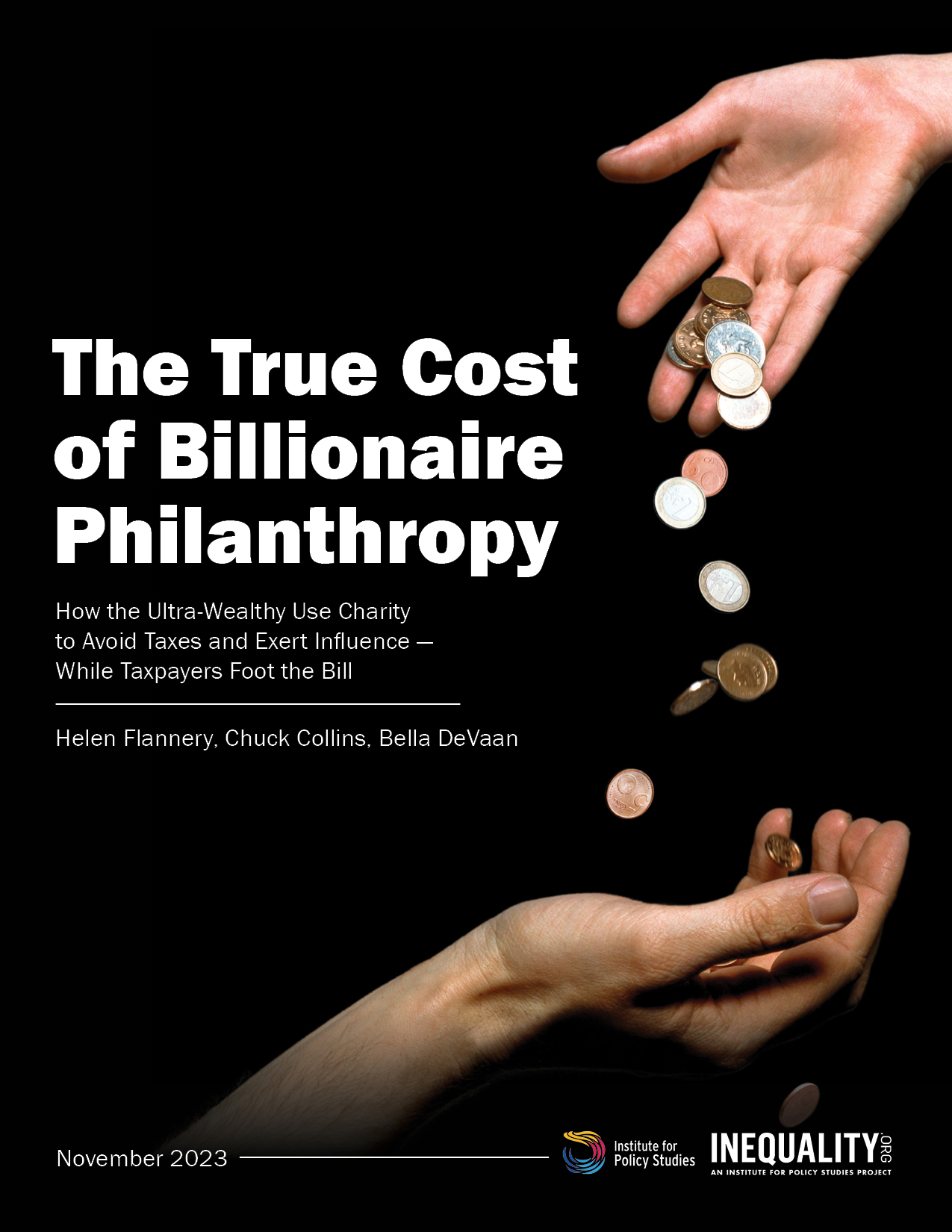The True Cost of Billionaire Philanthropy
Helen Flannery | Chuck Collins
Bella DeVaan
Introduction:
The news is full of stories about billionaires giving huge gifts to charity. Yet for all but the most generous, their giving is nowhere close to keeping up with the growth in their wealth.
While some are making an earnest effort to give back, others appear to be using charity to enhance their public image, their political voice, and even the protection of their assets. The billionaires who have taken the Giving Pledge — a promise to give away half of their wealth during their lifetimes or in their wills — offer examples of all of this.
Below, we share some highlights from our recent work on the pitfalls of top-heavy giving — and what to do about them. You can find a lot more detail in the full version.
Key Findings
Giving Pledgers promised to give their wealth away. As a group, they’re wealthier now than when they made the pledge.
- The 73 living U.S. Giving Pledgers who were billionaires in 2010 saw their wealth grow by 138 percent, or 224 percent when adjusted for inflation, through 2022. Their combined assets increased from $348 billion in 2010 to $828 billion over those twelve years.
- Of these 73 people, 30 have seen their wealth increase more than 200 percent when adjusted for inflation. Those with the greatest growth include Mark Zuckerberg and Priscilla Chan (1,382 percent), Dustin Moskovitz and Cari Tuna (1,166 percent), Elaine and Ken Langone (755 percent), Arthur M. Blank (739 percent), and Bernie and Billi Marcus (714 percent).
These high-end donors increasingly give to intermediaries rather than working charities.
- For the past several years, the favorite cause of ultra-wealthy donors like the Pledgers has been their own private foundations. Of the $12 billion in identifiable gifts of over $1 million that the biggest givers donated to charity in 2022, 68 percent went either to foundations or to Donor Advised Funds (DAFs).
- Overall giving to intermediaries has increased significantly, with 41 cents of every individual donation to charity now going to an intermediary. In 2022, 27 percent of individual donations went to DAFs and 14 percent to private foundations.
- Over the past 10 years, DAF assets have grown more than 411 percent. Meanwhile, the share of their assets they donate to working charities appears to be declining.
- Many Pledgers aren’t fulfilling their Pledges or have questionable fulfillment methods. A few have been bold and direct givers, but most need to pick up the pace significantly to make their Pledges real. And some seem to have used their philanthropy for self-serving purposes, such as taking out loans from their foundations or paying themselves hefty trustee salaries.
Some billionaires are blending their charitable giving with for-profit investment.
- Some Pledgers have started to do more of their giving through limited liability corporations, or LLCs. This creates an environment where billionaires combine or replace their charitable giving with impact investments — for-profit ventures that theoretically have a social benefit, but neither the transparency nor the proven beneficial impact of working charities.
- LLC-using Pledgers such as Pierre Omidyar and Mark Zuckerberg have said that they see impact investing as an integral part of their philanthropic efforts. They may well be considering these for-profit investments as counting towards their Pledge fulfillment.
High-end philanthropy is subsidized by regular taxpayers.
- $73.34 billion in tax revenue was lost to the public in 2022 due to personal and corporate charitable deductions.
- If we include just the little data we have about charitable bequests and the investments of charities themselves, the revenue loss is pushed up to roughly $111 billion.
- And if we also include the capital gains revenue lost from the donation of appreciated assets, the true revenue costs of charity likely add up to several hundreds of billions of dollars each year.
Top-Heavy Philanthropy by the Numbers
- Only a tiny handful of Giving Pledgers have actually given away half their assets to date, or have publicly announced that they have set up their wills to do so.
- In 2021, Giving Pledger Elon Musk donated $5.7 billion in Tesla shares to his foundation. The federal tax benefits of his donation amounted to about $4.6 billion, or almost exactly 30 percent of his adjusted gross income — the maximum he would be allowed to deduct.
- Giving Pledger Barron Hilton was one of our nation’s most generous billionaires: He gave away $1 billion to charity while he was alive and left $2.4 billion to the Conrad N. Hilton Foundation in his estate. However, the subsequent behavior of the Hilton Foundation raises questions about its use of his funds. In 2021, for example, it paid out $35,000 to each of at least six Hilton family members serving on the board.
- Billionaire hedge fund manager and Giving Pledger Paul Singer’s private foundation typically meets its annual payout requirement only through grants to DAFs. Of the grants it made from 2017 to 2021, 85 percent went to a DAF at J.P. Morgan Chase.
- The Zoom Foundation (no relation to the video-conferencing company) is the private foundation of billionaire hedge fund investor Stephen F. Mandel and his wife Susan. The foundation gave more than $263 million from 2017 to 2021 to the Fidelity Charitable Gift Fund. Their 2021 gift alone amounted to more than $90 million. These contributions made up nearly the entirety of their charitable distributions over those five years.
- The du Pont family’s Longwood Foundation pays its president, Éleuthère Irénée du Pont II, more than $300,000 in total compensation per year.
- The H.E. Butt Foundation pays upwards of $250,000 each year to its president, David M. Rogers, who is the husband of a Butt family heir.
- In 1997, corporate raider Carl Icahn donated $100 million in shares of American Railcar to his Foundation for a Greater Opportunity, gaining himself an estimated $45 million tax deduction. In 2005, Icahn learned that American Railcar was preparing for an IPO, and got his foundation to sell the shares back to him for the original $100 million. Icahn agreed to pay the charity $10 million up front and the remaining $90 million over the next five years. When American Railcar went public, Icahn’s shares immediately jumped to $150 million — but he didn’t pay the foundation back for ten more years.
Key Charity Reforms
It is time to modernize the rules governing philanthropy to discourage the warehousing of charitable funds, align tax deductions with the public interest, and encourage more broad-based giving.
Below, we list the most important reforms we can make now to accomplish these goals. For a more detailed description of actions that can be taken to reform U.S. charitable giving, please see our full list of policy recommendations at the IPS Charity Reform Initiative.
Reforms to Donor-Advised Funds
- Require a payout for donor-advised funds. We recommend that DAFs should be required to pay out all donations within five years after donations have gone into the fund, including any income earned on the original donations during that time.
- Increase DAF transparency and reporting. Donations to and from DAFs, as well as payout rates, should be publicly disclosed and reported on an account-by-account basis.
Reforms to Private Foundations
- Increase the annual foundation payout requirement. Foundations currently only have to distribute a minimum of 5 percent of their asset value to charity each year. We propose increasing the requirement to 10 percent of assets for foundations with assets over $50 million and 7 percent for all other foundations.
- Cap administrative overhead over one percent of assets from counting towards payout. This would reduce incentives for exorbitant internal spending on salaries, travel, and accommodations for board members and move more funds to active charities.
- Prohibit grants to DAFs from qualifying toward the payout requirement unless the DAF funds are granted back out to working charities within one year. This mirrors a provision currently included in President Biden’s 2023 budget proposal.
- Close loopholes that allow program-related and impact investments to be considered part of the payout allocation. No form of investment should be considered a charitable gift. Such activities can be continued, and even encouraged, but should not count toward the qualified payout distribution.
- Require foundation board independence. If a private foundation is truly a public interest organization, it should not have a board composed entirely of family members and paid staff. Foundations should have independent boards with rules similar to those governing public corporation boards in many states.
- Impose a ban on compensating family member trustees. To eliminate the potential for self-dealing, there should be an outright ban on compensation to founders and their family members for their services to the foundation.
Reforms to Reverse Top-Heavy Philanthropy
- Establish a lifetime cap on charitable gift deductions. Currently, we allow unlimited tax reductions to donors who have private foundations. A lifetime cap of $500 million would not discourage billionaires whose giving is genuinely motivated by generosity — but it would prevent donors from using charitable giving to reduce their taxes to zero indefinitely.
- Levy a wealth tax on DAFs and closely-held private foundations. A wealth tax, such as Senator Elizabeth Warren’s proposal to levy a 2 percent annual tax on wealth over $50 million, should also apply both to donor-advised funds and to private foundations that are closely controlled by donors. This would encourage the transfer of charitable funds to nonprofits, public foundations, and community foundations’ general funds that wealthy donors do not control.
- Create a new oversight system for foundations and charities. Excise tax revenue from foundations could fund a new independent watchdog organization. This new regulatory body would have broad authority not only to support the nonprofit sector and increase its effectiveness, but also to hold it accountable.

